Table for Two is a series focusing on two-player games. Today’s game is Strife: Legacy of the Eternals, a compact card game about battling for control of locations using your team of Champions. It has great artwork, surprising strategic depth, and perfect information.
At a glance: Strife is for 2 players, ages 14 and up, and takes about an hour to play (though there are variants for shorter or longer games). It’s currently seeking funding on Kickstarter and the pledge for a copy is $15; the expected retail price is at least $20, possibly higher depending on stretch goals that get unlocked. I would say you could play with younger players as long as they have some experience with figuring out how card powers interact with each other.
New to Kickstarter? Check out our crowdfunding primer.
Components:
- 20 Champions cards (2 sets of 10 each)
- 10 Locations cards
- 4 Score cards
- 1 Fatestone (8-sided die)
Each of the Champion cards has a name, a number (from 0 to 9) and two abilities: the Battle ability and the Legacy ability. The Location cards each have a name and an effect.
There’s a stretch goal listed that would add 3 event cards as well. The cards are all tarot-sized, so there’s plenty of room for both the game text and the fantastic artwork by Jonathon Powell. I was given a pre-production print-on-demand version at Gen Con, and even this one is quite nice. Vision 3 Games has been fine-tuning the text on the cards for clarity to ensure that you don’t need to keep referring to the rules, but at any rate the rules fit on one folded sheet of paper so you can get going quickly.
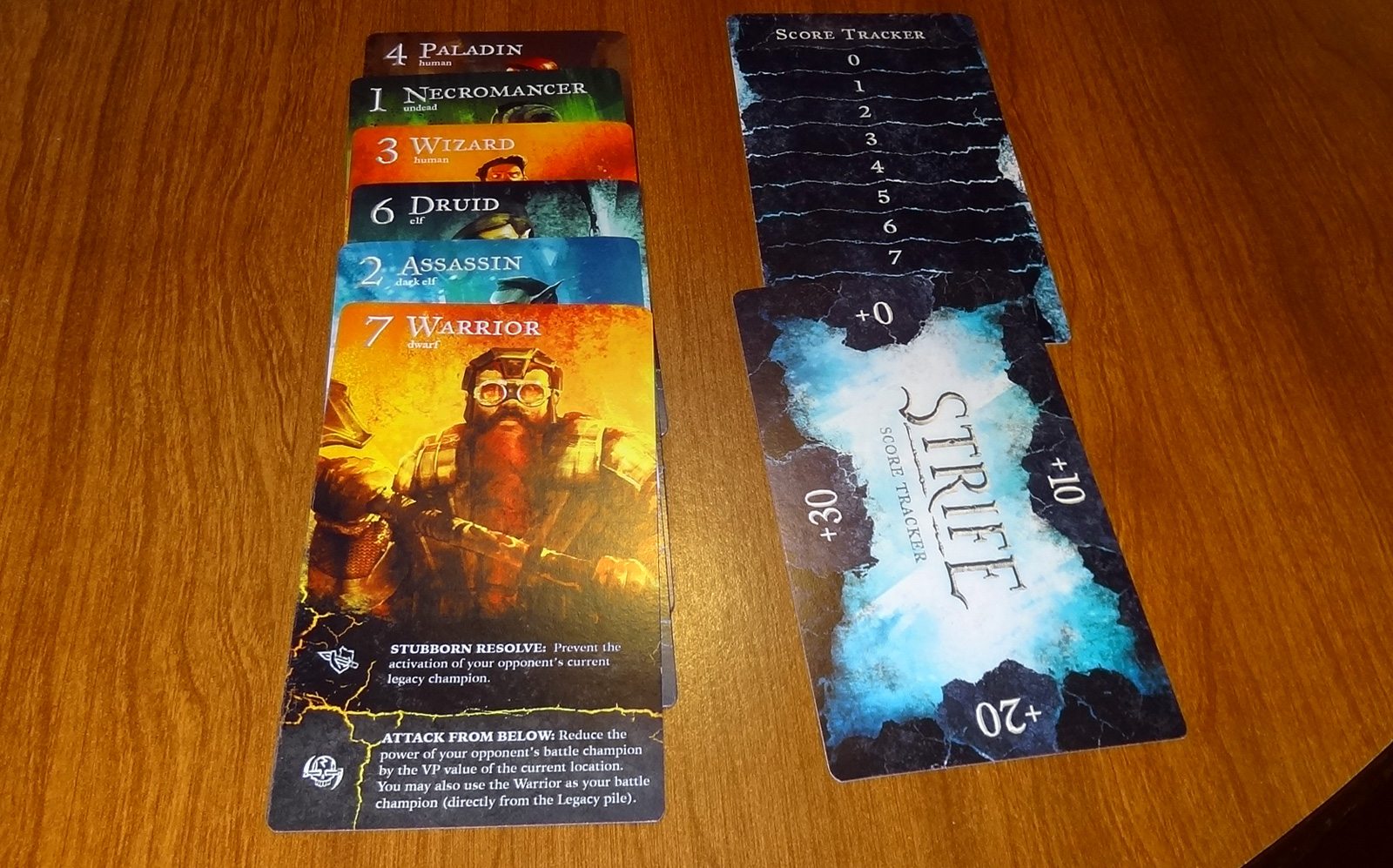
The score cards are a pair of cards: one has 0 to 9 printed vertically on the card, and the other has +0, +10, +20, and so on printed on the edges (on front and back, so it goes up to +70). You just slide one card over the other to keep your score from 0 to 79. It’s such a simple way to add a score tracker with just two cards per player that I’m surprised I don’t see this in tons of other games that require you to find your own way to keep score. It does help that they’re tarot-sized cards, though, because there’s more room so that a small nudge doesn’t translate to several points.
One thing that isn’t so great is that the text on the Location cards (indicating which Champions get combat bonuses at the Location) is very tiny, and hard to read from any distance. Although the ability text on the cards is fairly small, you have those in your hand so it’s not so bad. I do hope they make some of the text a little larger in the final version, or else you may need to resort to reading glasses.
How to play
You can get a PDF of the rules here, or even try the full Print-and-Play edition before you decide whether to back the game.
The object of the game is to score the most points in three rounds of play. (The length of the game can easily be adjusted by agreeing on more or fewer rounds.)
The basic idea is that each Champion has two powers: a Battle ability that triggers when it is used in battle, and then a Legacy ability that affects the next battle. You gain points by winning battles to take Location cards.
Each player gets a set of ten Champion cards and two score tracker cards. The ten Locations are shuffled, and three are set out on the table with the deck on one end.
Assign the Fatestone: each player will choose a Champion to be their first Legacy Champion–these are revealed simultaneously and set aside in the Legacy pile. Whichever player has the highest power level takes the Fatestone, which starts at 1. (In case of a tie, roll off for the Fatestone.)
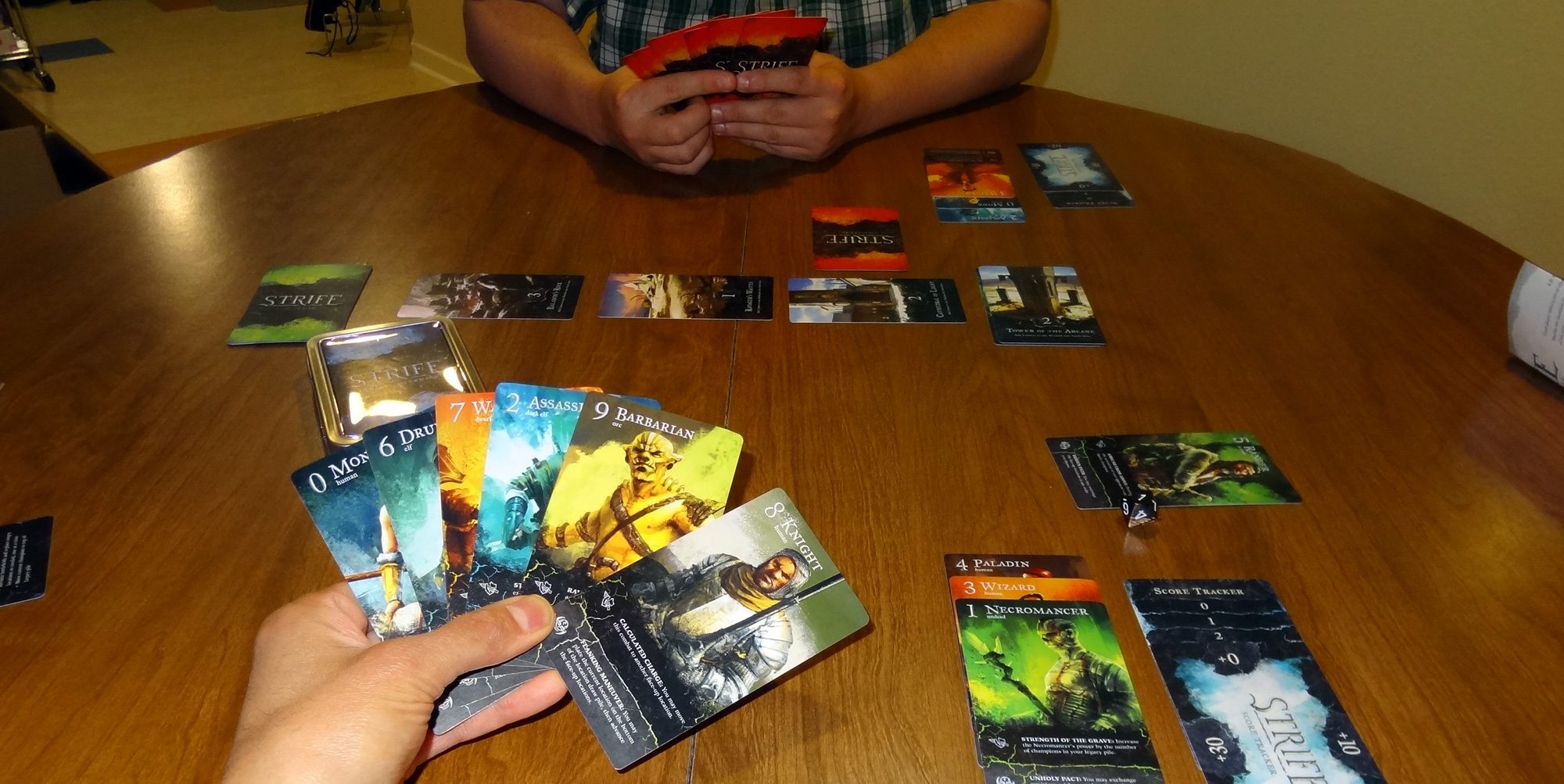
The basic idea is that you choose a Champion to play on the current Location–the one farthest from the deck. Players reveal their Champions simultaneously. Then, you activate the current Champions’ Battle abilities, and then the previous Champions’ Legacy abilities, and then resolve combat by adding terrain bonuses. Whoever wins combat by having the larger combat value gains victory points according to the Location card (and any ability bonuses). Then, the current Champion is moved into the Legacy pile, and the next battle begins.
At the end of the round, when each player is down to one Champion in hand, that one becomes the Legacy champion for the next round, and all the previously played Champions return to the hand. Locations are reshuffled.
The Fatestone is used to break ties. Any time there is a tie, for any reason, the person holding the Fatestone loses the tie. Or, if desired, that player may increase the Fatestone value by 1 and pass it to the other player to win the tie (only one pass per tie). At the end of the game, though, the Fatestone is worth victory points equal to its current value.
The regular game ends after three rounds–highest score wins. In case of a tie, the player with the Fatestone loses.
The Verdict
Despite the somewhat overblown Kickstarter video, Strife is really worth checking out. It’s a great two-player game that has a surprising depth for a game in which each player only has ten cards to choose from. It reminds me a little of BraveRats, which is also a sort of modified game of War, but is deeper because of the twofold abilities, the Fatestone, and the Locations.
The biggest part of the game, of course, is the abilities. They’re what drive the game and keep it from being just a game of playing the higher numbered card. What really makes this game shine, I think, is the way that each Champion affects both the current battle and the next battle. Even when you realize you’re probably going to lose a battle, you may be able to set up a later victory if you can get the right Champion into your Legacy pile. Even though there are only ten Champions, that interaction means there are 90 different one-two punches you can use against your opponent.
The downside to that, though, is that the game can drag if you or your opponent are prone to analysis paralysis. Toward the end of the round when you have fewer cards to choose from, it’s usually less of a problem, but when you’re trying to decide among eight different cards, it can be a bit of a brain-burner. The rules suggest playing without Battle abilities for the first game–just use the Legacy abilities–and I think it’s a good suggestion. You could play a couple games this way and still have a fairly rich experience, but then throwing in the Battle abilities adds a whole new level of interaction.
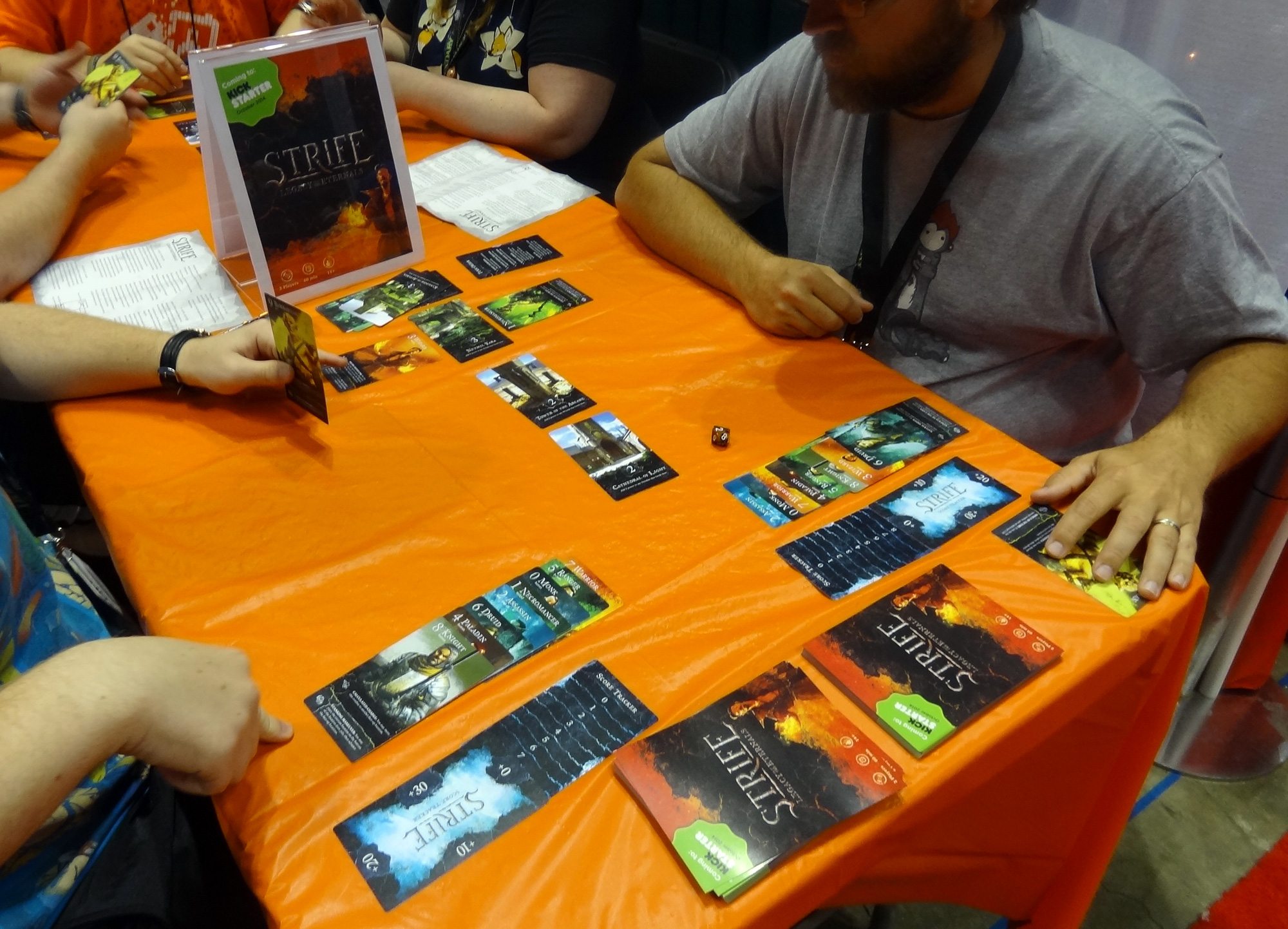
Strife uses perfect information: that is, everyone knows all of the options the other player has. The three available locations are public knowledge, of course, as is your total pile of Legacy Champions, so then you also know what’s left in your opponent’s hand. It’s not a matter of guessing what they might be holding–it’s figuring out which of those cards they’ll actually play against you. If you’re somebody who needs a little more luck and uncertainty in your game, you may find this a little more stressful.
I also really like the Fatestone idea. I don’t know if it’s completely original to Strife, but I haven’t seen tie-breaking done quite like this in any other game. Whenever there’s a tie, the player with the Fatestone has a decision to make: lose the tie, or give the opponent some points in order to win the tie. The more times the Fatestone is passed, the more points it’s worth, until at some point it’s not worth it to break the tie because the stone itself is worth more points… but at that point you’re resigned to losing all ties. It’s deliciously hard to decide when to stop passing it.
The game does last about an hour if you play three rounds (that’s after you get the hang of it), so depending on your preferences that may be just about right or a little long. Again, since you can easily adjust the number of rounds played, the game can be shortened or lengthened to fit your schedule. I do recommend playing at least two rounds, because the last Champion in your hand automatically becomes the first Legacy Champion for the next round, which gives that last decision a bit of weight to it.
Overall, I think Strife is an excellent two-player game. It has huge gameplay without being a huge game, and should be a hit for players who love powers that interact with each other. $15 is a great price for what you get, and there’s good replayability, too.
For more information, check out the Kickstarter campaign, which launched yesterday.
Disclosure: GeekDad received a demo prototype of this game for review.
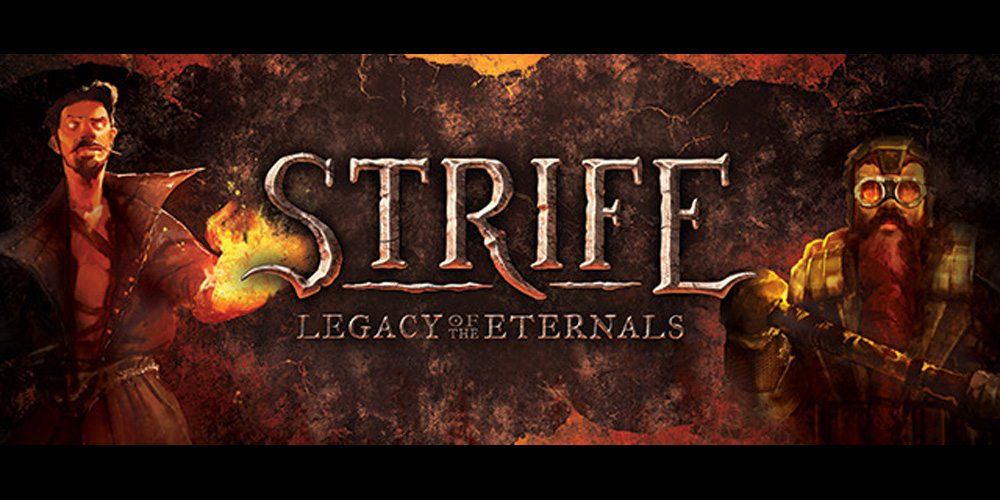

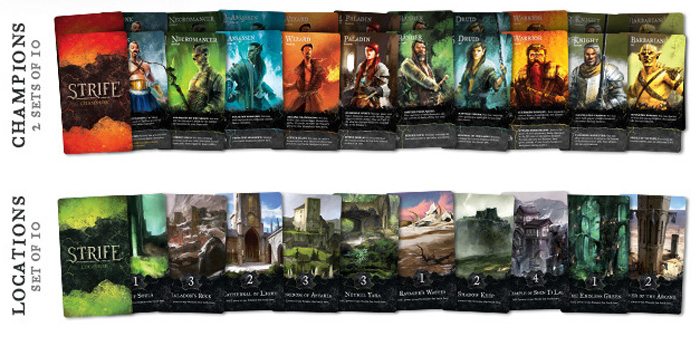

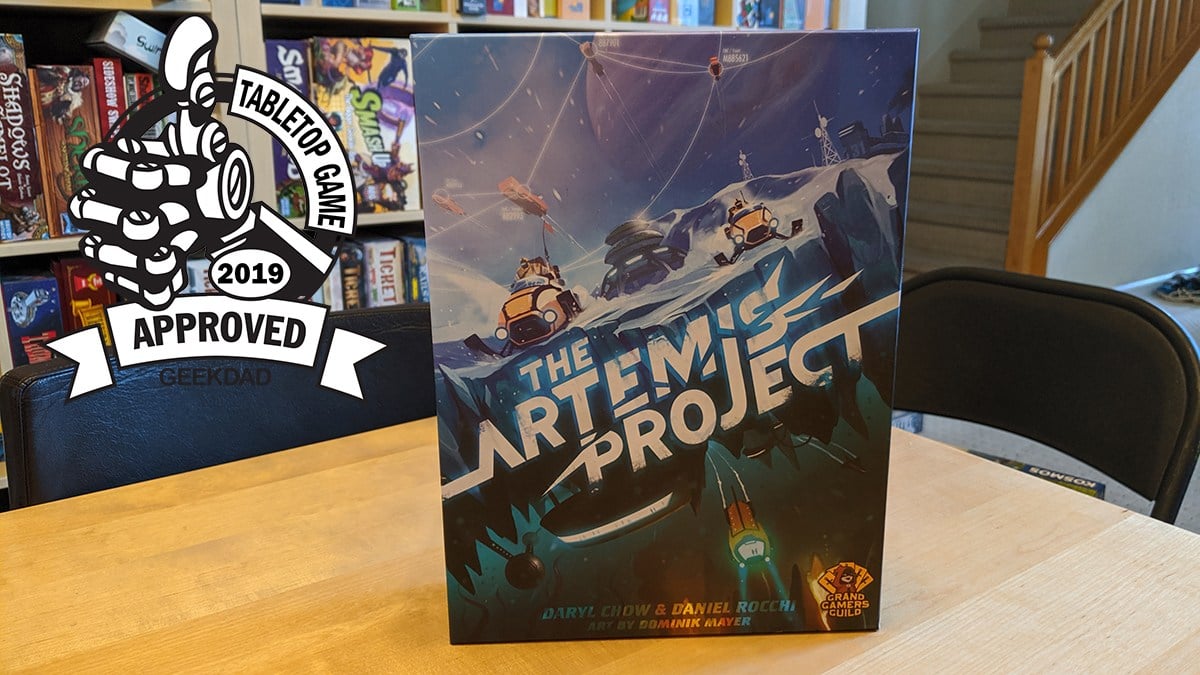
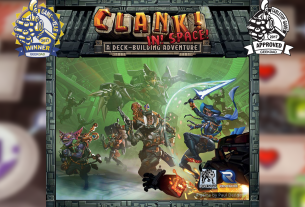
Oh look another Kickstarter on geekdad